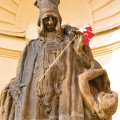OLD TOWN HALL
Construction of the Old Town Town Hall (Staroměstská radnice) was authorized in 1338 by Bohemian King John of Luxembourg. The inhabitants raised funds for its construction, but not enough to build a new building. So they bought an existing house, which was renovated and enlarged over the years with the acquisition of neighboring dwellings.
The first, Gothic, was purchased in 1338, and a tower with a chapel was later built next door. The second floor of the house has remained intact to this day, and is the room in which weddings are celebrated. The next is the Renaissance window with the inscription Praga caput regni (Praha, the head of the kingdom). The next two houses were purchased much later. In front of the Town Hall, Old Town Square is intimately entwined with Prague's history. It was here that the first "defenestration of Prague" took place (1419), and it was here that Klement Gottwald came to harangue the crowd during the "Prague coup" in 1948.
The tower of the Old Town Hall. It was built to symbolize and reinforce the political role of the complex. It rises to a height of 70 m. It's possible to climb up the tower and enjoy a marvellous view of the district. An inclined access ramp or an elevator can be used. The top is therefore easily accessible. At the foot of the tower, on the mosaic sidewalk, are twenty-seven crosses: a tribute to the twenty-seven nobles who refused Catholicism and, in 1618, defenestrated two guards and a secretary of the Habsburg sovereign, sounding the start of the Thirty Years' War. All were beheaded after the Battle of White Mountain.
In 1835, the municipality purchased the Maison au Coq (Rooster House) to the south of the building, linking it to the rest of the building. During a tour of the interior spaces, this house will catch your eye with its beautiful, perfectly preserved Romanesque reception room.
The "à la minute" house. Part of the ensemble of buildings that make up the Town Hall, the "minute house" (Dům U minuty) - so called because it housed a pharmacy accessible from all points of the Old Town in less than a minute - is remarkable for the sgraffito that covers its façade. They date back to the Renaissance and are one of the finest examples of this mural decoration technique. In 1896, it was the last of the buildings acquired to enlarge the town hall. The Kafka family lived here for seven years.
If you now return to the side of the Old TownSquare and take a close look at the façade, you'll notice that the construction lines seem to stop abruptly, as if part of the building were missing. This is due to the disappearance of the two wings to the north and east of the building, which were destroyed by fire during the Prague uprising at the end of the Second World War and never rebuilt. These successive additions on one side and amputations on the other explain the wobbly character and, in any case, the highly contrasting and totally atypical appearance of the Town Hall.
Go to the north-west corner of the Town Hall, where you'll find a small brasserie where it's said the Prague executioner used to hang out. In fact, he is depicted in a large pre-war painting on the restaurant's wall. In the background, you can also see the Town Hall in its original state, before the damage caused by the bombing. Visit at night, when the interior lighting enhances the mural: during the day, the groups of tourists gathered in front of the restaurant make it impossible to really linger.
Prague Astronomical Clock (Pražský Orloj). What grabs the public's attention (a crowd of curious onlookers, their eyes riveted to the screen of a video camera) at every hour is the Orloj, a 600-year-old astronomical clock whose original mechanism drives figures (the Twelve Apostles, Death, the Miser, the Vain Man, the Turk). These figures are recent, dating from 1948 and replacing those destroyed by the Nazis in 1945. The central dial uses three hands to indicate the position of the sun, moon and planets, as well as... the time.
To the left of the astronomical clock is the entrance portal to the tourist office. Dating from the late 15th century, it has all the hallmarks of late Gothic, with abundant decorative carving. Likewise, both walls of the entrance hall feature sumptuous mosaics designed by Mikoláš Aleš and dating from just before the war.
A guided tour of theinterior of the Town Hall is well worth taking: it allows you to admire all the different architectural styles: Gothic, Romanesque, Renaissance... Note the magnificent staircase leading to the upper floors, the Renaissance portal on the third floor and the coffered ceiling in the Maison au Coq. The highlight of the visit is the immense Council Chamber, admirable for the quality and density of its decorations. The view over the Place de la Vieille Ville and the houses lining it is well worth a visit, but a word of advice: don't get too close to the windows..
Did you know? This review was written by our professional authors.
Members' reviews on OLD TOWN HALL
The ratings and reviews below reflect the subjective opinions of members and not the opinion of The Little Witty.



















Le prix d’accès est très raisonnable.
C’est un lieu incontournable à mon avis.